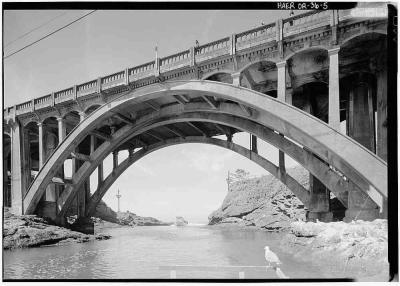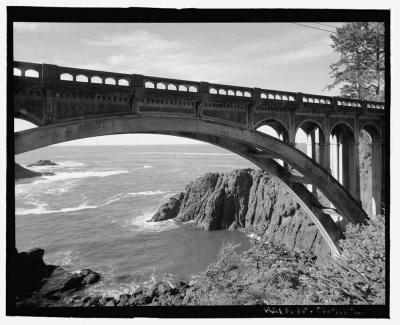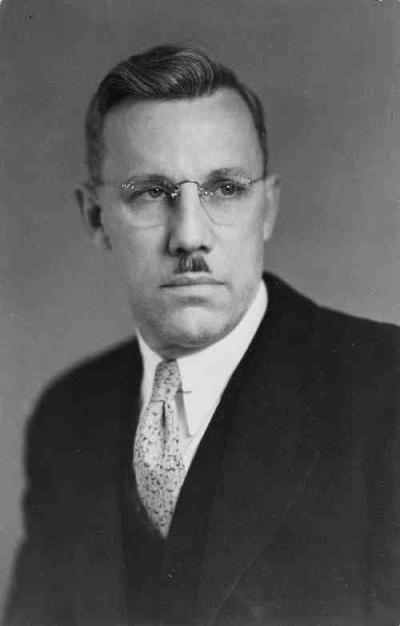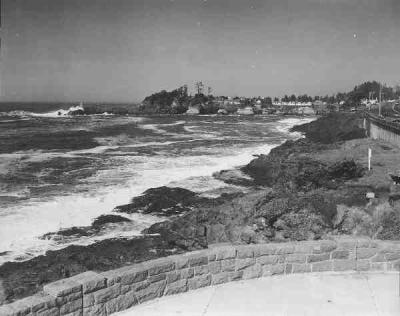
The Depoe Bay and Rocky Creek Bridges
The Depoe Bay Bridge was completed in 1927, and was only 18 feet wide. In 1940, a second span was built on the seaward side, making the bridge 48 feet wide with a sidewalk on each side and a walkway under the bridge. The bridge is 312 feet long and is located at milepost 127.6. The bridge was placed on the National Register of Historic Places on August 5, 2005.

The Rocky Creek Bridge (aka the Ben Jones Bridge) was also completed in 1927. The 20-foot wide bridge was rehabilitated in 2001, and while not listed in the National Register of Historic Places, it is eligible for inclusion. The Rocky Creek Bridge is located just south of town on Otter Crest Loop and is 360 feet long.

The Depoe Bay and Rocky Creek Bridges were designed by Oregon's masterbridge builder Conde B. McCullough. In 1919, he became the head of the Bridge Division of the Oregon Department of Transportation, making him personally responsible for the design of Oregon's bridges at a time when the state was completing Highway 101(then called the Roosevelt Highway). McCullough advocated that bridges be built economically and efficiently, his designs being also well known for their architectural beauty.
Establishing a Post Office
In 1928, the community applied for a post office under the name DePoe Bay, but when the federal approval returned the town’s name was listed as Depoe Bay, as it remains today. Edith Ferguson served as the first postmaster. Mrs. Ferguson also established the aquarium and owned Depoe Bay’s first grocery store and gas station. Her daughter, Pauline Holfert, coordinated the Fleet of Flowers for many years.

A World-Class Aquarium
In 1930, Paul Baird was busy putting the finishing touches on the new Depoe Bay Aquarium, which was owned and operated by H.L. Collins, J.C. Bradford, and Jerry Newman, all of Portland. The aquarium was situated 200 feet north of the bridge on the east side of the highway, with a rustic rock and cement entrance. It was the first saltwater aquarium in Oregon and was considered one of the best in the world at that time.
Outside the aquarium to the right of the entrance was a seal pool, and the keeper used to get in and wash the resident seal with a long-handled scrub brush. The young, bright-eyed seal loved this and would lay on his side while he was scrubbed. To the left of the entrance was another pool filled with sea roses, urchins, anemone, yellowtail rockfish, and crabs. The new aquarium was managed by G.P. Smith.
A giant octopus called “Kid Octopus” was the star attraction of the new aquarium, and liked to show off. There were 17 tanks inside, and the inhabitants were all acquired in the vicinity of Depoe Bay: squid, starry flounder, sandabs, California halibut, Blenny eel, Pacific cultus, hake, Tom cod, California sea trout, sculpin, China rockfish, black and yellow rockfish, Pacific white perch, striped perch, wall-eyed perch, cut-throat trout, silver salmon, bit skate, smooth round shark, red snapper, lingcod, sole minnow, round-nosed sole, wolffish, least perch, black rockfish, shore crabs, market crabs, hermit crabs, starfish, and blackfish. Tanks were beautified with eelgrass, several varieties of kelp, and ocean mosses.
By 1972, the aquarium was the third oldest in the nation. In the seal pool, a large fur seal named Alvin entertained visitors. Inside the building, entryway tanks held shrimp, colorful tube and plume worms, sea livers (Chiton), mussels, limpets, barnacles, oysters, many species of starfish, sea urchins, and sea cucumbers. One tank held a wolf eel with jaws so powerful that it was capable of snapping a 2x4 in half or chomping off a steel gaff hook. An adult eel could be as long as eight feet. The aquarium usually housed three-four octopuses. In the heart of the aquarium, Numerous humorous harbor seals swam about their tiled pool, barking as they slapped their wet chests with their flippers in their efforts to get more fish. Other tanks held crabs, flounder, sole, lingcod, sea perch, kelpfish, anemones, sculpin, red snapper, sea bass, and grouper. As was true in the past, the specimens were caught locally. The aquarium closed its doors for the final time in September of 1998.

Depoe Bay Elementary School
Depoe Bay had an elementary school from 1933 through 1968. The building, which now houses City Hall, taught 30-40 children each year in two classrooms. Each classroom had three grades. When the school was established, there were 77 school districts in the area and 105 schools that served the children. By 1991, those numbers had shrunk to 18 schools served by one district (Lincoln County).
The children were fortunate to be able to take field trips to the beach, the county seat, and a variety of other community resources rich in educational value. Instruction in subject areas as suggested in the state guides was richly supplemented by a great variety of other materials, and provided work at the achievement level of each pupil. Depoe Bay Elementary School graduates were consistently at the top of their classes when they went on to junior high school.
Outstanding art projects were presented as well as promoting an interest in ecology through “save the birds” and anti-litter campaigns. A music teacher visited the school once a week to give the students band and vocal music instruction. A gym teacher also came once a week for specialized exercise and gymnastics activities. Team sports weren’t an option because of the small enrollment, but abundant playground equipment was provided as well as a covered area which offered shelter for playing outdoors during rainy weather.
The schoolhouse was also used by parents for community plays. Locals gathered frequently at the school for entertainment and social gatherings. Among the actors were Russ Hunter, Betty Taunton, Stan Allyn, Alexia Bates, Russ Bailey, Pauline and Fred Holfert, Sid and Melissa Neal, Ted and Muriel Mudrow, and Bev Poling. Bev Poling, mother of Beanie Robison, Suzi Robison Snyder, Pogo Robison, Krista Robison Watson, and twins Lars Robison and Liz Robison Martin, remembered the school as the social center of the community: The PTA was a very active group – the social hub. We just did things.”
Children in Depoe Bay were relatively independent, allowed considerable freedom to explore the reaches of the town and use the bay as their playground. Many had rowboats which were used recreationally on the bay. There was little crime, and parents were more comfortable allowing children to roam without supervision.
The Wild Life Museum
The Depoe Bay (Wild Life) Museum opened on May 7, 1937. The museum was valued at $75,000 and boasted the egg collection of J.C. Braly of Depoe Bay and Ed Currier of St. Johns, which was said to be the most complete collection on the coast, containing eggs of all birds found in Oregon (over 3,000 eggs). Indian relics unearthed in 1867 at Castle Rock, Washington were also displayed, including papoose boards, totem poles, and stone relics. There were over 500 stuffed birds, an agate display (stones were gathered locally), and a 200-specimen butterfly collection. Stuffed animals, heads, or skins included all species of Oregon deer, black bear, Alaska timber wolf, moose, elk, buffalo, bobcat, mountain lion, red fox, and coyote. There were several pictures from the 1905 Lewis & Clark fair.

The Seawall
The State of Oregon constructed the main seawall in 1941.
Petitioning for a Liquor Store
By 1947, Depoe Bay had grown to a population of about 500, and seeking a liquor store, a petition with 437 resident signatures was submitted to the liquor commission.
Depoe Bay Gets a Church
In 1949, after four years of conducting Sunday school and church services in the Community Hall, Depoe Bay’s community church was established. A sealed metal box containing a white bible with a brief history of church work in Depoe Bay inside it was placed into the cornerstone.
